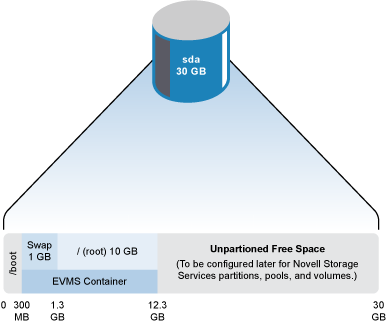D.1 Installing Linux with EVMS as the Volume Manager on the System Device
To use NSS on the same drive that contains the /boot, swap, and root (/) partitions, that drive must be managed by EVMS. The default volume manager in OES Linux is the Linux Volume Manager 2 (LVM2), not EVMS. Unless you modify the partitioning scheme during the operating system install, the system device is not managed by EVMS, and you cannot create NSS data volumes on that drive.
The simplest solution is to put your Linux system volumes on one device that is managed by LVM2 (the default configuration), then add devices that can be configured to use EVMS for your NSS pools and volumes.
Using EVMS to manage the system device allows you to later add NSS pools and volumes on any unparttioned free space on it. However, you must modify the partitioning scheme to use EVMS during the install. It is not possible to change the volume manager for the system device after the install.
From the YaST Installations Settings page, you go to the Partitioner page, then do the following to set up the EVMS partitioning scheme. For detailed instructions, see Installing with EVMS as the Volume Manager of the System Device
in the OES 2 SP2: Installation Guide.
-
Delete the proposed LVM2-based partitioning solution.
-
Create a boot partition of about 300 MB on the system disk with a /boot mount point.
-
Create a system partition of 5 GB to 11 GB on the system disk where you will create the EVMS container for the swap and root (/) volumes.
-
Do not partition the remaining space on the system device. This unpartitioned free space can be used after the install for NSS pools and volumes or for Linux POSIX file systems.
-
Select EVMS Configuration, then select the system partition. This step ensures the device is managed by EVMS.
-
Create an EVMS container for the system partition of type .
-
Create the swap volume of about 1 GB in size in the EVMS container.
-
Create the / (root) volume of 4 GB to 10 GB in the EVMS container.
For example, Figure D-1 illustrates how a 30-GB device can be configured during the install to enable EVMS to be used as the volume manager. The /boot volume is placed at the beginning of the device. An EVMS container is created, then the swap and / (root) volumes are created in it. The remainder of the device is left as unpartitioned free space.
Figure D-1 Example of a System Device Configured for EVMS and NSS

IMPORTANT:Only the boot and system partitions are configured. The remainder of the device remains as unpartitioned free space where you can create NSS pools and volumes after the install.